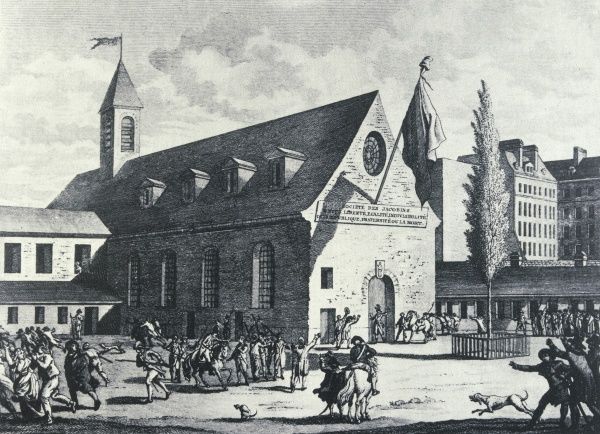Jacobin Club, Which Group of People Did Not Join the Jacobin Club?
There were a few groups that were not part of the Jacobin club. They included shopkeepers, artisans, pastry cooks, watchmakers, printers, and daily wage workers. These groups did not join the Jacobin club, but still had many supporters and were active in the French Revolution.
Cordeliers
Table of Contents
The Cordeliers, also known as radicals, met in a convent on the left bank of the Seine, and were a more radical group than the Jacobins. They fought for a more democratic franchise and were led by Danton. Their actions were responsible for the split in the Jacobins, and many of them were killed during the July 1791 massacre.
The RW also made similar demands. They called for tougher action against the Right and for heavier taxes on the rich. They also proposed the formation of women’s battalions. These similarities made the RW and Cordeliers common cause in many ways, including crushing profiteers and mass-arming the people. The RW delegation also promoted a women’s program at the Jacobins. A spokesman for the group said, “Women are not domestic animals.”
Despite being pro-Jacobin, RW did not join the Jacobin club. They did not ask for permission to meet at the club, but made announcements to the men. Later, they moved to other quarters at Saint-Eustache. However, the Jacobin leadership remained cautious and did not want the society to become too violent.
The Jacobins were not the only group in France that did not join the Jacobin club. There were a number of Jacobin notables who attacked RW on general political grounds. Some accused RW of siding with Jacques Roux’s friend Leclerc. They also complained that Lacombe is constantly pushing the group into everything.
Despite these differences, the Club continued to be a hub of democratic radicalism. During the Terror in 1793-4, it supported the government, and its leaders were imprisoned and killed for criticizing the rule of the Convention. After the Terror, the Club was also subjected to the same persecution as the Jacobins.
The Cordeliers’ emblem is an eye that radiates from the summit of a mountain. The motto, ‘Freedom is the sun’, reflects the club’s universalist view of freedom. Their copper tokens also carry an open eye, representing revolutionary vigilance.
The Jacobin club was originally a closed group for deputies in the Assembly. To become a member, one had to be a ‘active citizen’ and pay 24 livres a year. This membership tended to attract people of the middle and upper classes. By May 1790, there were about 1,500 members. Meetings were held four times a week, and discussed issues of political policy and the questions that were brought to the National Constituent Assembly.
Montagnards
The Jacobin Club had two main factions: the Mountain group and the Girondists. The Mountain group was led by Robespierre. They opposed the Girondists, but eventually took control of the Jacobin club. Although the Girondists had many supporters in the Assembly, they were not accepted by the Montagnards.
After the ascension of the Convention, the Montagnard consensus eroded, and several prominent Montagnards were denigrated by counterrevolutionaries. This was in part due to conspiracy theories that emerged in the political press and formulated by journalist-legislators.
The Girondists and the Jacobins were rival groups in the French Revolution. The Girondists supported the weak executive branch of government while the Jacobins advocated strong legislative and judicial branches. Both factions were at odds with each other, and this struggle marked the course of the French Revolution.
The Jacobins were divided into several factions and did not have a traditional symbol. The Montagnards’ emblem was a reinterpretation of the medallion held by the Musee Carnevalet in Paris. The medallion depicts a pike surmounted by a Phrygian hat and the date 1793. The medal was made by the engraver Pierre Joseph Tiolier and is a very high quality example.
The Montagnards also opposed the Girondins in the 1790s. They fought against the Gironddins in the National Convention and attempted to ban Girondin leaders from holding office. On May 31, they entered the Convention building, making similar demands. Some Montagnard deputies made speeches in support of these demands. The Convention dithered for a while, and radical Montagnards were able to mount a tribune and argue for the expulsion of the Girondins.
After the French defeated the Prussians in the Battle of Valmy, the country was divided on whether to wage war against its neighbors. The Montagnards opposed the war, while the Girondins favored it. They believed that war was necessary to spread the revolution across Europe and promote patriotic pride at home.
Unlike the Girondists, the Montagnards did not join the Jacobin Club. However, they were part of the French Revolution for a long time. They fought against the monarchy and the church and supported the republican cause. But in the end, their efforts failed and they were expelled from the country.
Jacobin clubs were a group of people who did not join the jacobin club
The Jacobin Club was the most important political group in France during the French Revolution. Along with the Cordeliers, it played an important role in the Storming of the Bastille. Other influential groups included the Pantheon Club, the Feuillants Club, and the Society of 1789. Some members of these groups, such as radical journalist Jean-Paul Marat, were also Jacobins. The Jacobins were also responsible for setting up the new state religion and calendar. They became so influential that the term “Jacobin” is still used today to describe certain branches of French politics.
The Jacobin Club drew members from the lower classes of society. These people were often called sans-culottes, which means “without knee breeches.” The Jacobin Club derived its name from a former Paris convent of St. Jacob. The Jacobins were a political organization and an illuminized form of Freemasonry.
Some of the members of the Jacobin Club were expelled after the Revolution, but many of their leaders remained. As a result, the Jacobin Club split into two main factions. One was the Mountain group, or Montagnards, who sat on the top benches in the Assembly. They opposed the Girondists and eventually gained control of the Jacobin Club.
The Jacobin Club was the most influential political group during the French Revolution. It was a revolutionary group that had over 500,000 members by 1792. They were formed in a Dominican convent on the Rue St. Honore in Paris, and soon gained power under Maximilien Robespierre. The Jacobins supported the most radical phase of the French Revolution, which was characterized by universal equality, freedom, and brotherhood.
Jacobin clubs were formed in 1789 and played a variety of roles in the French Revolution. They were originally formed by Breton deputies of the States-General. After the National Assembly was moved to Paris, they were reorganized as the Society of Friends of the Constitution. They met in a former Dominican convent and sought support from outside the Assembly. Later, they expanded their membership and affiliated with Jacobin clubs throughout France.
Read on: usglobalworld.com




